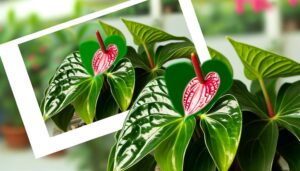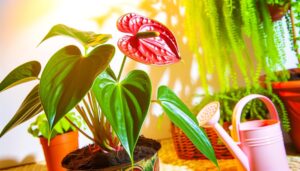Growing Anthurium Hybrids in Water – A Step-by-Step Guide
Start by choosing robust Anthurium hybrids like Anthurium andraeanum, ensuring roots are firm and foliage is perfect. Prepare sterile, clear containers with drainage holes.
Use distilled or RO water, maintaining a pH of 5.5-6.5. Clean the roots meticulously and prune damaged parts.
Position your plant in bright, indirect sunlight, avoiding direct exposure to prevent leaf burn. Monitor root health, trimming any overcrowded or discolored roots.
Regularly test water quality to maintain adequate oxygen and nutrient levels. By following these detailed steps, you’ll successfully cultivate thriving Anthurium hybrids in water.
Explore further for in-depth guidance.
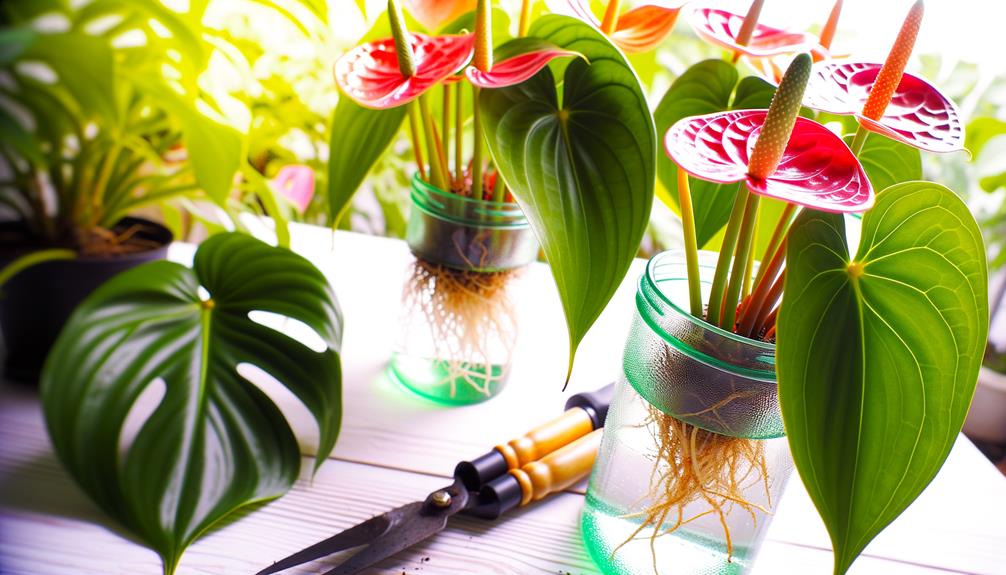
Key Takeaways
- Select healthy Anthurium hybrids with vibrant foliage and inspect roots for firmness and absence of rot.
- Use clear, sterilized containers with appropriate depth and drainage holes to ensure oxygenation and root health.
- Plant in distilled or filtered water, maintaining pH levels between 5.5 and 6.5 for optimal nutrient absorption.
- Position the plant in bright, indirect sunlight, avoiding direct exposure to prevent leaf burn.
- Regularly monitor water quality, ensuring proper pH, dissolved oxygen levels, and nutrient concentration for healthy growth.
Choosing the Right Anthurium
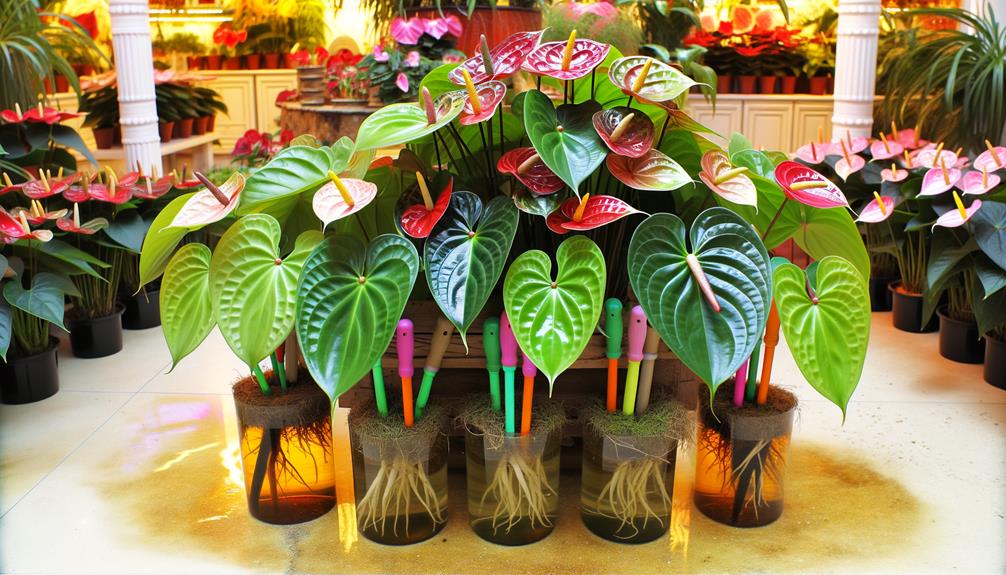
Selecting the best Anthurium hybrid involves evaluating its root structure and water tolerance to guarantee successful hydroponic growth.
First, inspect the roots; they should be white, firm, and free of rot or disease. Avoid plants with brown or mushy roots.
Next, choose hybrids known for high water tolerance, such as Anthurium andraeanum or Anthurium clarinervium. These types adapt well to hydroponic environments.
Assess the foliage for signs of robustness—leaves should be vibrant and free of blemishes.
Preparing the Containers
To prepare the containers for your Anthurium hybrids, start by selecting clear glass or plastic vessels, which allow for easy monitoring of root health and water levels. Make sure the containers are sterilized to prevent pathogenic contamination.
Follow these steps:
- Sterilization: Immerse the vessels in a solution of 10% bleach to eliminate bacteria and fungi. Rinse thoroughly with distilled water.
- Drainage: Drill small holes at the base if using plastic containers, ensuring sufficient oxygenation and preventing root rot.
- Support System: Add a layer of inert materials like pebbles or marbles to stabilize the plant and provide structural support.
Selecting the Water

When selecting water for your Anthurium hybrids, guarantee it meets high-quality standards, as impurities can affect plant health.
Use distilled or filtered water to avoid contaminants, and maintain an ideal pH level between 5.5 and 6.5 for peak nutrient absorption.
Regularly test the water to guarantee consistency and adjust as needed.
Water Quality Requirements
Best water quality is vital for successfully growing Anthurium hybrids in a hydroponic environment. To guarantee ideal conditions, follow these steps:
- Use Distilled or Reverse Osmosis (RO) Water: Tap water often contains minerals and contaminants that can harm your Anthurium. Distilled or RO water provides a clean slate, free from impurities.
- Monitor Total Dissolved Solids (TDS): Maintain TDS levels between 50-150 ppm. High TDS can lead to nutrient imbalances, while low TDS ensures nutrient uptake efficiency.
- Maintain Water Temperature Stability: Keep water temperature between 18-24°C (64-75°F). Temperature fluctuations can stress the plant and inhibit growth.
Ideal Ph Levels
Maintaining an ideal pH level of 5.5-6.5 is crucial for optimal nutrient absorption and overall health of your Anthurium hybrids in a hydroponic setup. First, use a reliable pH meter to test your water. Regularly monitor and adjust the pH using pH up or pH down solutions. Proper pH guarantees macronutrients like nitrogen and micronutrients such as iron remain bioavailable.
| pH Level Range | Solution to Use |
|---|---|
| Below 5.5 | pH Up Solution |
| 5.5-6.5 | No Adjustment Needed |
| Above 6.5 | pH Down Solution |
Planting Techniques
To initiate the process of growing anthurium hybrids in water, begin by carefully removing the plant from its soil medium and gently washing the roots to eliminate all soil residues. This is important for preventing microbial contamination.
Next, follow these steps:
- Root Pruning: Trim any damaged or excessively long roots using sterilized scissors to promote healthy growth.
- Container Selection: Choose a transparent vessel to monitor root health and make sure it’s deep enough to accommodate the root system.
- Water Quality: Fill the container with distilled or rainwater, maintaining a consistent water level just above the root base to prevent desiccation.
Light Requirements
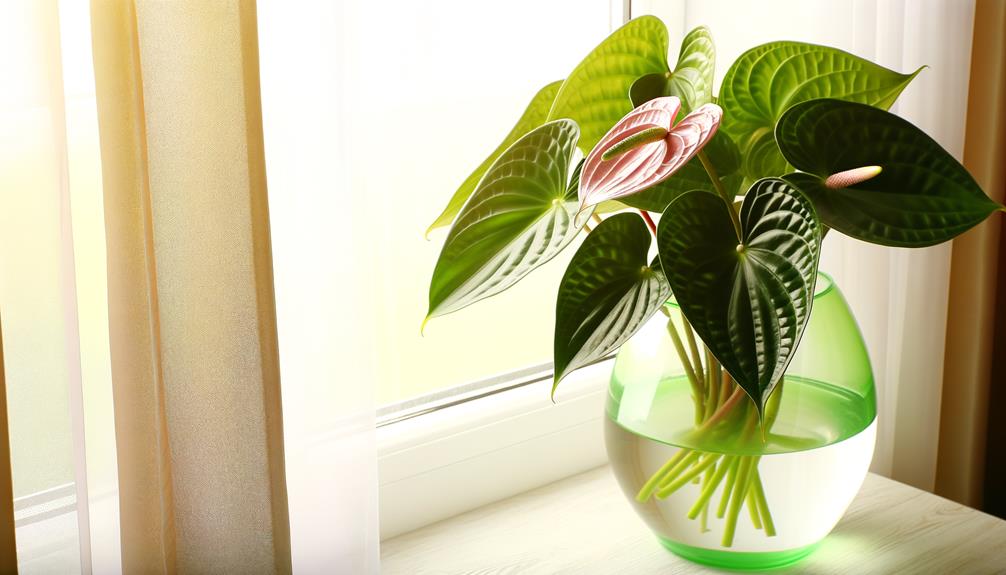
After verifying the roots are properly pruned and submerged, position your anthurium hybrid in a location where it receives bright, indirect sunlight for optimal photosynthesis and growth.
Direct sunlight can scorch the leaves, while insufficient light will impede flowering and foliage development.
Aim for approximately 2000-2500 foot-candles of light intensity. Monitor light levels using a light meter or smartphone app.
| Light Condition | Description |
|---|---|
| Direct Sunlight | Harsh rays causing leaf burn |
| Bright Indirect Light | Ideal for photosynthesis and growth |
| Low Light | Stunted growth, poor flowering |
| Filtered Light | Via curtains or blinds |
Rotate the plant periodically to guarantee even light exposure. This helps maintain symmetrical growth and vibrant foliage, maximizing the aesthetic appeal of your anthurium hybrid.
Temperature and Humidity
Maintain your anthurium hybrid thrives by maintaining a constant temperature range of 70-85°F (21-29°C) and a relative humidity level of 60-80%. These conditions mimic the plant’s natural tropical habitat, ensuring ideal growth and health.
To achieve this, you should:
- Install a Hygrometer: Regularly monitor humidity levels. If levels drop below 60%, use a humidifier to adjust.
- Temperature Control: Place your anthurium in a location free from drafts and away from heating or cooling vents that cause temperature fluctuations.
- Humidity Trays: Position a tray with water and pebbles beneath the plant. As the water evaporates, it increases ambient humidity around the plant.
Nutrient Needs
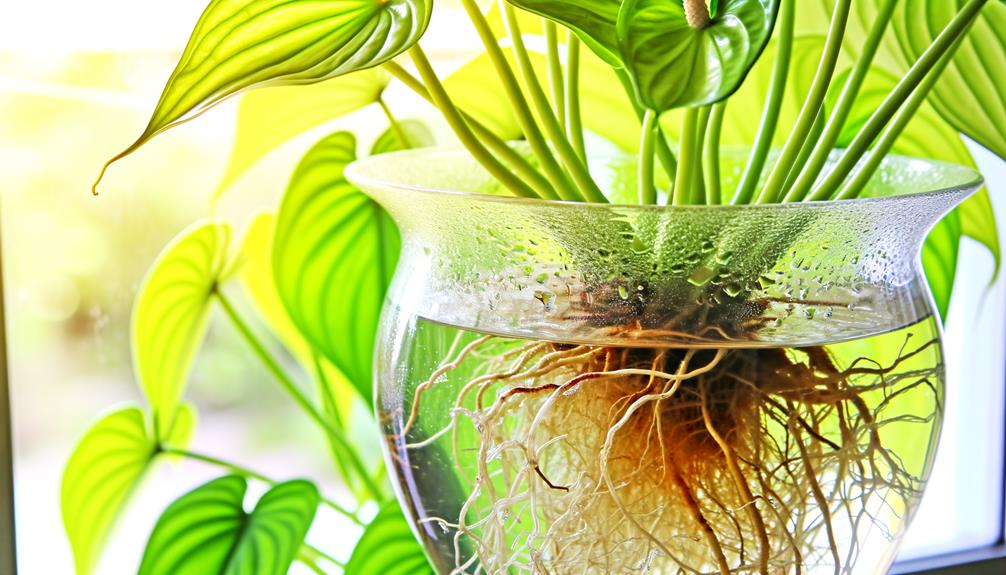
Maintaining your anthurium hybrids to receive ideal nutrition involves using a balanced, water-soluble fertilizer with an equal ratio of nitrogen, phosphorus, and potassium (N-P-K) such as 20-20-20.
You should mix the fertilizer at a quarter strength to avoid over-fertilization. Apply it every four weeks to sustain growth and vibrant blooms. Monitor pH levels, aiming for a range of 5.5 to 6.5 for best nutrient uptake.
Here’s a quick reference table:
| Nutrient | Function | Deficiency Symptoms |
|---|---|---|
| Nitrogen | Promotes leaf and stem growth | Yellowing leaves, stunted growth |
| Phosphorus | Aids in root development and flowering | Poor root growth, weak flowering |
| Potassium | Enhances overall plant health and vigor | Yellowing leaf margins, weak stems |
Consistently track these parameters to optimize your plants’ well-being.
Common Issues
When growing anthurium hybrids in water, you might encounter common issues such as root rot, nutrient imbalances, and pest infestations that require prompt attention.
- Root Rot: Maintain the roots submerged but not overly saturated. Use clean, non-chlorinated water and change it regularly to prevent anaerobic conditions. Examine roots for brown or slimy textures; trim affected areas immediately.
- Nutrient Imbalances: Monitor the water’s pH, aiming for 5.5 to 6.5. Use a balanced, water-soluble fertilizer, but avoid over-fertilizing. Look for symptoms like yellowing leaves (chlorosis) to adjust nutrient levels.
- Pest Infestations: Inspect plants regularly for signs of aphids, spider mites, or mealybugs. Treat infestations with insecticidal soap or neem oil, ensuring thorough coverage of all plant surfaces.
Pruning and Maintenance
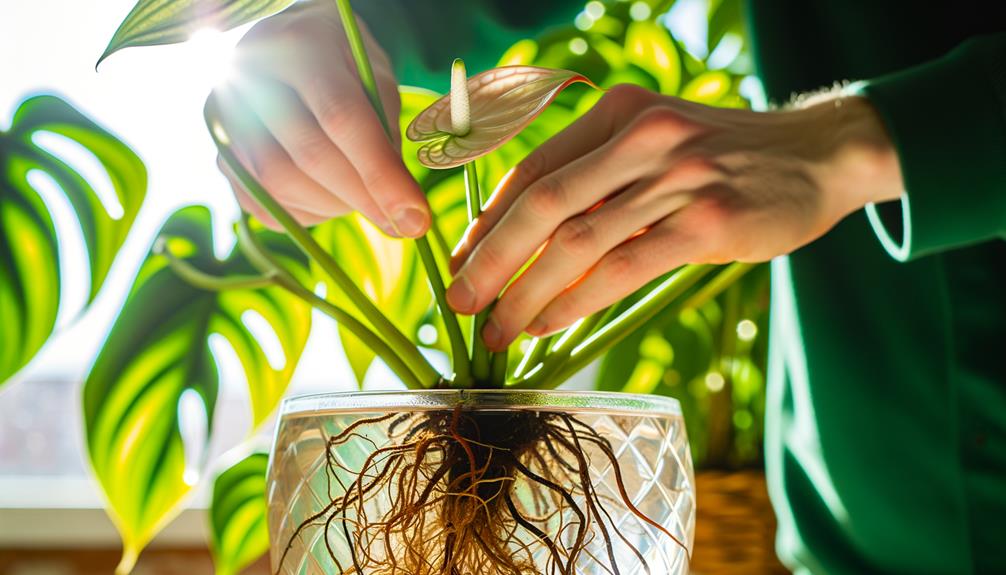
For ideal growth of your Anthurium hybrids in water, regularly prune dead leaves using sterilized scissors to prevent disease spread.
Control root growth by periodically trimming excessive roots to avoid nutrient imbalances.
Continuously monitor water quality, ensuring it stays free from algae and contaminants, to maintain plant health.
Trim Dead Leaves
Pruning dead leaves from your Anthurium hybrids is essential for promoting healthy growth and preventing disease. Begin by sterilizing your pruning shears with isopropyl alcohol to eliminate pathogens.
Identify leaves that are yellowing, browning, or showing signs of necrosis. Make clean cuts close to the base of the petiole using the following steps:
- Locate the Dead Leaves: Inspect the plant regularly and identify any compromised foliage.
- Sterilize Your Tools: Use isopropyl alcohol to cleanse your shears before each cut.
- Prune Precisely: Cut at the base of the petiole, ensuring not to damage healthy tissue.
Control Root Growth
Controlling root growth in your Anthurium hybrids involves periodic pruning and maintenance to prevent overcrowding and ensure efficient nutrient uptake.
Begin by carefully removing the plant from its water vessel. Inspect the root system for overcrowded, entangled, or decaying roots.
Use sterilized pruning shears to trim away any dead or discolored roots, cutting just above the healthy tissue.
To promote healthy growth, prune back overly long or excessive roots, maintaining a balanced root-to-shoot ratio.
After trimming, rinse the roots with clean water to remove any debris. Reposition the plant in fresh water, ensuring roots are fully submerged but not compacted.
Regular pruning and maintenance will promote vigorous root health and ideal growth conditions for your Anthurium hybrids.
Monitor Water Quality
Consistently monitoring the water quality for your Anthurium hybrids is vital to prevent the buildup of harmful substances and maintain ideal growth conditions.
Utilize a water testing kit to regularly check parameters such as pH, dissolved oxygen, and nutrient levels.
Here’s what you need to do:
- Check pH Levels: Maintain a pH between 5.5 and 6.5. Use pH adjusters if needed.
- Monitor Dissolved Oxygen: Guarantee the water contains at least 6 mg/L of dissolved oxygen. Aerate the water if levels drop.
- Assess Nutrient Concentration: Measure nitrogen, phosphorus, and potassium levels. Use a balanced liquid fertilizer to replenish nutrients.
Conclusion
To conclude, growing anthurium hybrids in water is like mastering a delicate dance. Choose the appropriate species, prepare optimal containers, and use clean, dechlorinated water.
Make sure they receive indirect sunlight and maintain temperatures between 65-80°F with 60-80% humidity. Regularly monitor nutrient levels, watch for common problems like root rot, and prune as necessary.
By following these scientific recommendations, you’ll cultivate flourishing anthuriums that are as colorful as they’re tough. Happy growing!



